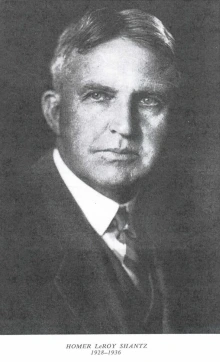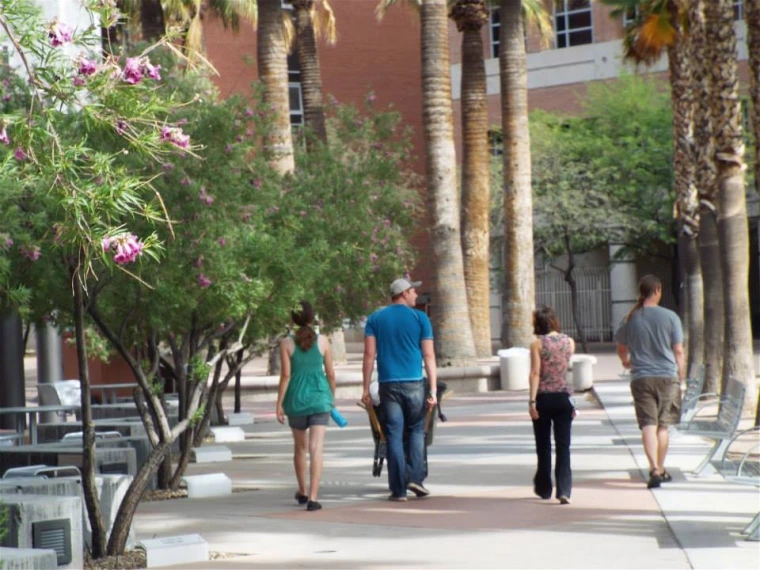
Homer LeRoy Shantz
Shantz photo collection
The University of Arizona has been a leader in desert horticulture since its inception in 1891. Now, the UA Campus Arboretum preserves that legacy by selecting, and planting new trees, and by preserving historic campus trees and landscapes. To honor the tradition started by pioneering faculty in the College of Agriculture who used the campus grounds for experimentation, the UA Campus Arboretum continues to locate and plant new species to test their suitability for our southwest climate and urban setting. By selecting new species that fit the criteria defined in the Plant Collections Policy, we ensure that future selection builds responsibly on past success. In this way, we continue to build a campus landscape that models the very best choices for sustainable landscapes.
The effort of finding and testing new trees for campus often requires partnerships throughout an international botanical community, both those interested in sonoran native plants, and other arid-adapted choices from around the world. These donors are incredibly diverse ranging from the UA Campus Arboretum's founding director, Elizabeth Davison, Boyce Thompson's research arm - the Desert Legume Program, and Landscape Architect Warren Jones, to former UA President, and world-renowned botanist Homer Shantz, Iraqi Government leaders and even Libyan Politician Muammar Gaddafi. Their generosity and an on-going commitment to planting trees has created a landscape that is diverse, familiar and welcoming to all within our campus community.

As we preserve this campus tradition of landscape stewardship, we are also engaging and training the next generation of urban tree conservationists as our student interns have taken a leadership role in new tree installation. They have initiated review of available literature on each species to guide them in selecting campus sites where each specimen is most likely to flourish, installed the trees according to standards set by the International Society of Arboriculture, and irrigated the trees until established or until Grounds Services sets up irrigation. As part of their work, they undertook a special task in 2014 to initiate a challenge of planting 30 Trees in 30 days . Some of the trees planted were grown from seed by previous undergraduate interns and volunteers to preserve rare plants in our collection, others were donated by various partners. In all, 44 plants were installed in 30 days and more are waiting in the greenhouse for 2015! Most are low-water use and cold tolerant legumes from DELEP, and all were matched to their location to optimize their chances of establishing and thriving with minimal inputs. We are thankful to be in a position to promote hope as we look to the future in planting these new trees, and as we train the leaders of future generations.
30 TREES IN 30 DAYS CHALLENGE:
For Arbor Day 2014, and in honor of our fourth consecutive year as a Tree Campus USA, we set a goal to plant 30 trees in 30 days! Here is a list you can use to check on the plants we installed. Undergraduate student interns continue to research information relating to each species' botanical characteristics, ethnobotanical uses, cultivation, natural history, current classification. Detailed botanical photographs are also be created for each species. As this work is complete, each species description page will be populated more completely.
| Acacia cana | 3 |
|---|---|
| Vachellia erioloba | 2 |
| Mariosousa millefolia | 4 |
| Vachellia vernicosa | 4 |
| Acacia pruinocarpa | 2 |
| Senegalia wrightii | 2 |
| Mariosousa willardiana | 2 |
| Dichrostachys cinerea | 4 |
| Moringa oleifera | 2 |
| Prosopis laevigata | 3 |
| Senna aphylla | 2 |
| Zapotecha formosa var. schotii | 1 |
| Bulnesia retama | 2 |
| Jatropha cuneata | 1 |
| Jatropha dioica | 1 |
| Acacia acuminata | 1 |
| Quercus toumeyi | 1 |
| Prunus campanulata | 2 |
| Lagerstroemia indica | 2 |
| Quercus shumardii | 2 |
| Carnegiea gigantea | 2 |
| Total Trees Planted in 30 Days* | 44 |

